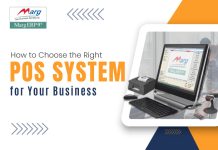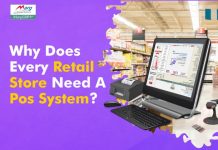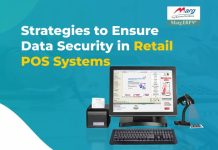The evolution of shopping has been remarkable. With the rise of technology, online shopping has gained immense popularity. Yet, offline shopping continues to hold its ground, offering unique experiences. Let’s dive into the differences, advantages, and benefits of offline and online shopping, and how tools like Marg ERP can enhance your shopping or business experience.
Understanding Offline Shopping
Offline shopping refers to the traditional way of purchasing goods and services by visiting physical stores. Whether it’s a bustling mall, a local market, or a boutique store, offline shopping has been a staple for consumers worldwide.
Advantages of Offline Shopping
- Tangible Experience: Offline shopping allows customers to physically touch, feel, and try products before buying them. This is especially beneficial for items like clothing, shoes, and electronics. The advantages of offline shopping make it easier for consumers to make more informed purchasing decisions, especially for high-value items.
- Instant Gratification: Unlike online shopping, where you may have to wait for delivery, offline shopping offers immediate possession of purchased items. This is one of the key advantages of offline shopping that appeals to many consumers who value the instant availability of their purchases.
- Personalized Assistance: Sales representatives in stores provide real-time guidance, making it easier to make informed decisions. They can also offer insights into how specific products or services, such as those related to restaurant billing software, can be best utilized in your business.
- Trust and Transparency: Offline shopping builds trust, as customers can verify product quality and authenticity directly. The advantages of offline shopping include the ability to check the durability and quality of products, ensuring they meet your standards before purchasing.
- No Shipping Costs: Since you purchase items directly from the store, you save on delivery charges, which are often added to online orders. This makes offline shopping an even more attractive option for consumers looking to save money.
- Social Interaction: Shopping in physical stores fosters social interaction, be it with shopkeepers, staff, or fellow shoppers, adding a personal touch to the experience.
Disadvantages of Offline Shopping
- Limited Operating Hours: Physical stores operate within fixed hours, limiting flexibility for shoppers with busy schedules. One of the key disadvantages of offline shopping is that these limited hours can make it challenging for those with hectic lives to shop conveniently.
- Time-Consuming: Traveling to stores, navigating through crowds, and standing in queues can be time-intensive. This makes it one of the most noticeable disadvantages of offline shopping, especially for people who value efficiency.
- Higher Costs: Offline stores often have higher overhead costs, which can be reflected in the pricing of products. This is another common disadvantage of offline shopping, where customers may end up paying more for the same item compared to online options.
- Limited Variety: Unlike online shopping platforms, physical stores may have limited inventory, restricting choices. This can often be a significant disadvantage for shoppers who are looking for specific products that may not be available in-store.
Online Shopping: A Modern Alternative
Online shopping involves purchasing goods and services through websites or mobile applications. It has transformed the way consumers shop by offering convenience and accessibility.
Benefits of Online Shopping
- 24/7 Convenience: Online stores are always open, allowing you to shop anytime, anywhere.
- Extensive Product Range: Online platforms offer a wider selection of products than physical stores, often across multiple categories.
- Price Comparisons: Easily compare prices across different websites to find the best deals and discounts.
- Time-Saving: Avoiding travel and long queues makes online shopping a time-efficient option.
- Doorstep Delivery: Items are delivered directly to your home, saving effort and transportation costs.
- Customer Reviews: Online shopping provides access to reviews and ratings, helping you make informed purchasing decisions.
Disadvantages of Online Shopping
- Delayed Gratification: You need to wait for delivery, which might take days or even weeks.
- No Physical Interaction: You can’t touch or try the product before purchase, which can lead to dissatisfaction.
- Return Hassles: While returns are possible, the process can be time-consuming and inconvenient.
Online vs Offline Shopping: Key Differences
- Convenience:
- Online Shopping: Accessible 24/7 from anywhere, offering unmatched convenience.
- Offline Shopping: Requires visiting physical locations, making it less flexible.
- Product Variety:
- Online Shopping: Boasts an extensive range of products across categories.
- Offline Shopping: Limited to the inventory available at a specific store.
- Pricing:
- Online Shopping: Often offers discounts and deals due to lower operational costs.
- Offline Shopping: Pricing can be higher due to store maintenance expenses.
- Customer Experience:
- Online Shopping: Cannot physically inspect products, relying heavily on descriptions and images.
- Offline Shopping: Provides a hands-on experience, fostering trust and satisfaction.
- Return Policies:
- Online Shopping: Offers hassle-free return policies but may involve waiting periods.
- Offline Shopping: Returns and exchanges are straightforward but might require revisiting the store.
Benefits of Offline Shopping
- Human Interaction: Building relationships with store staff can enhance the shopping experience.
- Instant Solutions: Issues like defective items can be addressed immediately without the wait.
- Authenticity Assurance: Ensuring product authenticity is easier when shopping offline.
- Local Economy Support: By shopping offline, you contribute directly to local businesses and economies.
How Marg ERP Can Help in the Shopping Ecosystem
Whether you run a retail store or an e-commerce business, Marg ERP offers comprehensive solutions to streamline your operations:
- Inventory Management: Track stock levels effortlessly, whether for online or offline stores. Marg ERP ensures accurate inventory tracking, reducing shortages or overstock issues.
- Billing Solutions: Generate fast, accurate invoices for offline stores or manage online billing seamlessly with Marg ERP’s POS and billing software.
- GST Compliance: Stay tax-compliant with Marg ERP’s automatic GST filing features, making financial management hassle-free.
- Customer Relationship Management: Build loyalty with your customers by offering personalized services and maintaining detailed records of their purchases.
- Seamless Integration: Marg ERP integrates with e-commerce platforms and offline POS systems, ensuring a unified approach to business management.
- Analytics and Reporting: Make informed decisions with detailed insights into your sales performance, customer preferences, and inventory trends.
Online vs Offline Shopping: What Should You Choose?
When it comes to shopping, the decision between online and offline shopping largely depends on your personal preferences, needs, and the shopping experience you’re seeking. Both options have their unique benefits, and understanding these can help you decide which one is right for you.
Choose Offline Shopping If:
- You Value a Hands-on Experience
Offline shopping offers a tactile experience that online shopping can’t replicate. Being able to touch, try, and test products in person is a big advantage for many shoppers. Whether it’s trying on clothes or testing gadgets, this hands-on approach helps you make more confident purchasing decisions. - Personalized Customer Service Matters
If you prefer one-on-one interactions, offline shopping is likely the better choice. Store staff can offer tailored advice, help you find exactly what you’re looking for, and answer any immediate questions you may have. This personal touch can enhance your overall shopping experience, something that online shopping might lack. - You Enjoy the Social Aspect of Shopping
Offline shopping often brings with it the enjoyment of spending time with friends or family. Whether you’re browsing stores together or just enjoying a trip to the mall, the social experience of offline shopping can turn it into a fun outing.
Choose Online Shopping If:
- Convenience and Flexibility Are Your Priorities
When it comes to convenience, online shopping is hard to beat. You can shop anytime, from anywhere, and have your purchases delivered directly to your doorsteps, all without the need for planning trips to physical stores. This is a major advantage of online shopping compared to offline shopping. - You’re Looking for a Wider Range of Products and Better Deals
The internet offers a vast selection of products that many brick-and-mortar stores simply can’t match. Additionally, online shopping makes it easier to compare prices, find discounts, and take advantage of promotions, giving you access to better deals than what you might find in stores. - Avoiding Crowds and Saving Time Is Crucial
If you’re someone who prefers to avoid crowds, long lines, or the hassle of parking, online shopping is a great option. It allows you to shop at your own pace, without the stress of navigating through busy stores. This time-saving aspect of online shopping makes it an ideal choice for those with a tight schedule.
Final Thoughts
While online shopping has revolutionized the retail landscape, offline shopping continues to hold its charm. Understanding the benefits and drawbacks of each will help you make informed shopping decisions. To further enhance your shopping or business management experience, Marg ERP provides cutting-edge tools tailored for retailers, ensuring seamless operations and unparalleled efficiency. Whether you’re an advocate for traditional shopping or a fan of digital convenience, Marg ERP is here to support your journey.
Frequently Asked Questions
What are the main advantages of offline shopping?
Offline shopping offers a tangible shopping experience, instant gratification, and personalized assistance, making it a preferred choice for many.
How does online shopping differ from offline shopping?
Online shopping provides convenience, extensive product variety, and competitive pricing, while offline shopping emphasizes physical interactions and immediate purchases.
Are there any disadvantages to offline shopping?
Yes, offline shopping can be time-consuming, limited in variety, and often comes with higher costs due to overhead expenses.
Why is offline shopping still popular despite the rise of e-commerce?
Offline shopping remains popular due to its trust factor, the ability to inspect products physically, and the social aspect it brings.
Can online and offline shopping coexist?
Absolutely! Both formats cater to different needs and can complement each other, offering consumers the best of both worlds.




















